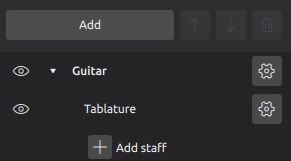Customizing a tablature staff
Changing tuning
- Right-click on the staff and select Staff/Part Properties…
- Press the Edit String Data… button at the bottom of the dialog box. This opens the String Data dialog:

- Under Strings tuning, click on a string pitch and select Edit String…; Alternatively, just double-click the string pitch.
- Select a new pitch in the Note Selection box and click OK. Alternatively, just double-click the new pitch.
- Click OK to close the “String Data” dialog box.
- Click OK to close the Staff/Part Properties dialog.
Notes: (1) If the tuning is changed on a tab staff that already contains some notes, fret marks will be adjusted automatically (if possible); (2) Any change of tuning to a particular instrument applies only to the score at hand, and does not change any program default settings.
Adding or removing strings
Add a string
- Right-click on the staff and select Staff/Part Properties…
- Click on Edit String Data…
- Click on a string pitch and select New String…
- Select the new pitch and press OK; alternatively, just double-click the new pitch.
The new string is inserted below the selected string. You will also need to adjust the number of lines in Staff/Part properties→Advanced style properties.
Delete a string
- Right-click on the staff, select Staff/Part Properties…
- Click on Edit String Data…
- Click on a string pitch and press Delete String.
Note: After deleting a tablature string you will also need to adjust the number of lines in Staff/Part properties→Advanced style properties.
Mark unfretted string “open”
For an instrument such as the Baroque lute, this feature is used to mark a bass course as unstopped—i.e. always played open like a harp string. This means that only a fret mark indicating a zero fret can be displayed.
To mark a bass course as unstopped:
- Right-click on the staff, and select Staff/Part Properties...
- Click on Edit String Data…
- Check the required boxes in the Open column.
See also Period tablature notation.
Change number of instrument frets
This property defines the maximum fret number which can be entered on a tablature staff.
- Right-click on the staff, and select Staff/Part Properties…
- Click on Edit String Data…
- Select or enter a new number using the “Number of frets” spinner.
Changing tablature staff type
MuseScore provides a range of common tablature types. If you want to change the tablature type, choose one of two options:
Change staff type from Instruments panel
- Ensure that the Instruments panel is visible (toggle F7).

- Click on the arrow next to the instrument name to reveal the staves.
- Click on the edit cog next to the desired staff and choose an option from the "Staff type" dropdown.
- To close, press Esc, or click outside the dialog.
Change staff type from Staff/Part properties
- Right-click onto an empty area of the staff and select Staff/Part Properties….
- Click on Advanced Style properties, select the desired option from "Template", then press < Reset to Template. You can fine tune the display if necessary using the "Fret Marks" and "Note Values" tabs.
- Click OK twice to exit.
Note: For customization options in detail, see Customizing appearance of tablature (below).
You will find the terms "simple", "common" and "full" in the tablature type names:
- Simple: Displays just fretmarks.
- Common: Displays fretmarks, rests, stems and beams.
- Full: Displays fretmarks; rests, stems and beams, half-note stems.
Customizing appearance of tablature
Tablature staff properties
- Right click on the staff and select Staff/Part Properties…
- Click on Advanced Style Properties….
This gives you access to a full range of tablature customization options. See Staff properties: Tablature options.
Tablature staff style
Global settings are set in Format→Style→Tablature styles.